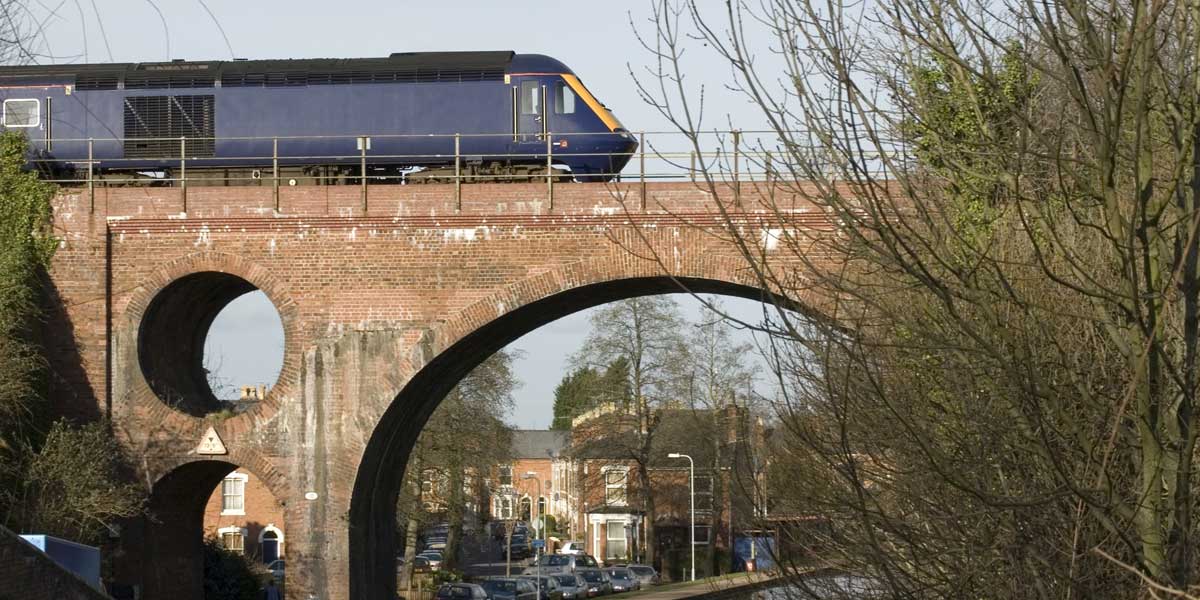The Cotswold Line, England
The Cotswold Line is a 139.2 km railway line between Oxford and
Hereford in England. The Cotswold line service carries passengers
through the rolling hills of Oxfordshire and Gloucestershire and on to
the more rugged charms of Herefordshire via Great Malvern, which has
one of the finest stations in the country.
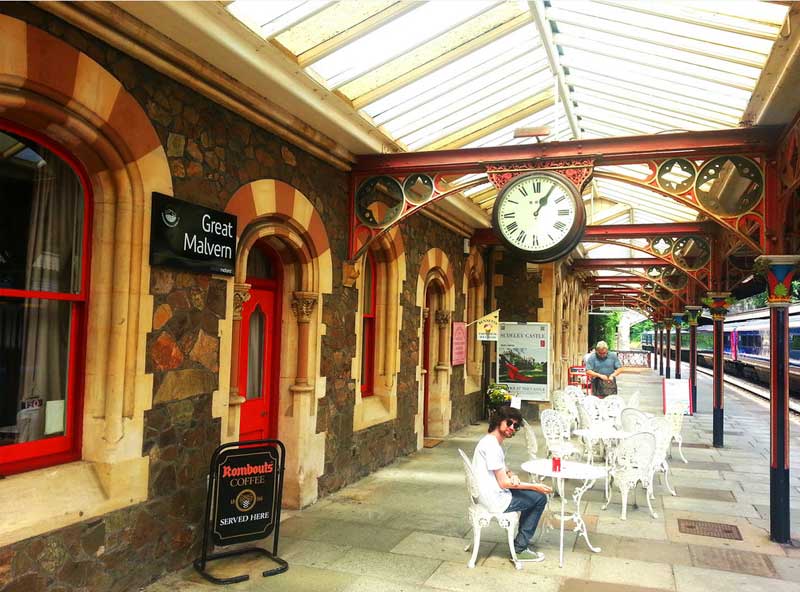
Great Malvern station
The line carries on over the Ledbury viaduct, one of the glories of
the line, which was built using 5m bricks, enough to make 300 homes,
and on to Hereford. The busiest stations on this line are the city
stations at Oxford, Worcester and Hereford, followed by Great Malvern.
The busiest station served exclusively by Great Western Railway's
Cotswold Line services is Charlbury, followed by Hanborough.
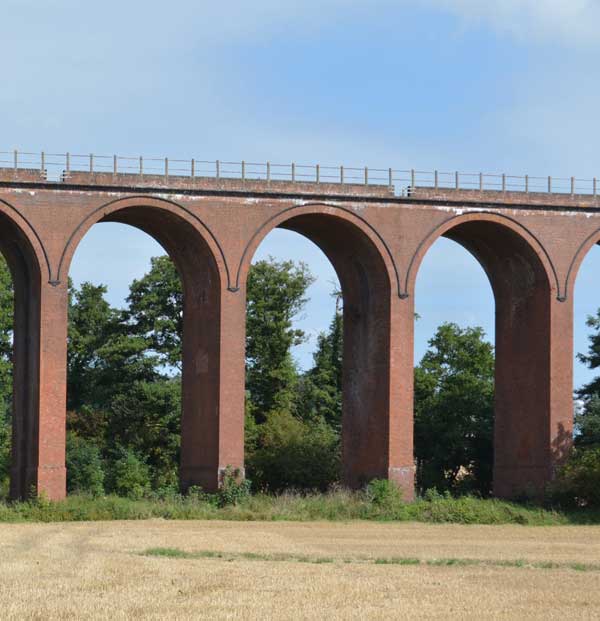 Ledbury viaduct
Ledbury viaduct
The Journey
Oxford to Charlbury
After departing Oxford station, the Cotswold Line shares track with
the Cherwell Valley Line to Banbury. About 200 m north of the station,
the line crosses the Sheepwash Channel which links the Castle Mill
Stream and Oxford Canal with the River Thames. Immediately east of the
current line is a swing bridge over the channel which used to carry the
London and North Western Railway's Buckinghamshire Railway line to its
terminus at Oxford Rewley Road railway station. The swing bridge is a
listed building. The Rewley Road station building has been dismantled
and re-erected at Buckinghamshire Railway Centre. The built up area
east of the railway, visible across the Oxford Canal, is Jericho, a
district which originated as lodgings outside the city walls where
travellers could rest if they arrived after the gates were locked. The
Eagle Ironworks of William Lucy & Co. was near the first road
bridge over the track on Walton Well Road.
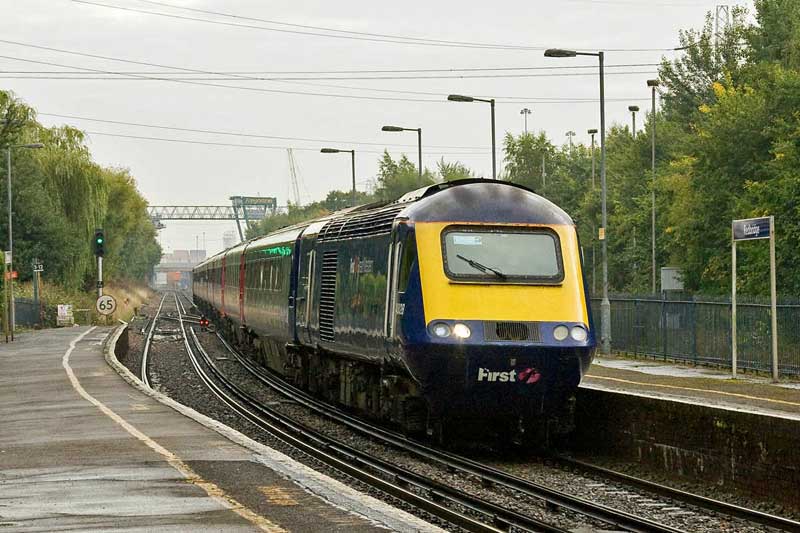
After the bridge, the open area to the left is Port Meadow, a water
meadow bordering the Thames with a Bronze Age round barrow. The former
LNWR Buckinghamshire Railway branches away to the north east. The
section from Oxford to Bicester has been connected to the Chiltern Main
Line by a new chord at Bicester, enabling through trains from Oxford to
London Marylebone to run from September 2015. Proposals exist for
re-opening the whole line and are included in the Draft Milton Keynes
& South Midlands Sub-Regional Strategy, but there are many planning
and funding matters to be resolved.
The line passes through Wolvercote. To the west, Lower Wolvercote was a centre for paper making, mainly for the Oxford University Press from the 17th century until 1998 and is the site of Godstow abbey, a Benedictine convent founded in the 12th century. The line passes under the viaduct carrying the A34 Oxford Western Bypass and 91 m further under the A40 road linking London and Fishguard.
The line now turns west; here the former Buckinghamshire Junction Railway link with the Buckinghamshire Railway used to converge from the east. About 6.4 km after Oxford station, Yarnton station was in the short stretch between here and where the Witney Railway diverged to the south-west. So far, the line has been close to the River Thames but the river now swings away to the south through a landscape dotted with gravel pits. The line now climbs the valley of the River Evenlode repeatedly crossing and re-crossing the river. Hanborough station serves the villages of Long Hanborough, Church Hanborough, Freeland and Bladon. The Oxford Bus Museum is next to Hanborough station.
From Hanborough the line enters the Cotswold Area of Outstanding Natural Beauty and 1.6 km beyond Hanborough is Combe station. Building the line through Combe was difficult with several deep cuttings, four crossings of the Evenlode, and the diversion of a length of the river. To the south, just after the third river crossing are the remains of North Leigh Roman Villa. About 1.6 km beyond the villa the line crosses the course of Akeman Street Roman road. The Oxfordshire Way long-distance footpath follows Akeman Street from the north east to a point about 1 km north of the railway before turning to run through Stonesfield and meet the line at Charlbury station. The next station is Finstock. Between Finstock and Charlbury the deer park to the west of the line is Cornbury Park, original venue for the Cornbury Music Festival, which has now been replaced by the Wilderness Festival. The woodlands south west of the park are the remains of Wychwood Forest named after the Hwicce, one of the Anglo-Saxon peoples of Britain. Charlbury station is the start of the redoubled track and is first stop for faster trains over the line and retains its original Oxford, Worcester and Wolverhampton Railway clapperboard building. This is section of track has a maximum speed of 160 km/h (100 mph).
Charlbury to Moreton-in-Marsh
The line is now heading south-west and the site of Ascot d'Oilly
Castle is to the north-west as the train enters Ascott-under-Wychwood.
Few trains call at Ascott-under-Wychwood station, but there is a signal
box controlling the level crossing and the points that were formerly
the end of the single track section from Wolvercot Junction. 1.9 km
beyond Ascott is Shipton station which serves the villages of
Shipton-under-Wychwood, Milton-under-Wychwood and Fifield.
Still following the Evenlode, the line now turns north-west. There is
another level crossing near Bruern Abbey. The next junction on the line
was at Kingham from where the Banbury and Cheltenham Direct Railway
went west to Cheltenham via Stow-on-the-Wold and east to King's Sutton
near Banbury. Kingham village is north of the station. The village west
of the station is Bledington.
Moreton-in-Marsh to Hereford
About 45 km after Oxford is Moreton-in-Marsh. This was once the
southern end of the Stratford and Moreton Tramway. The line then passes
the corner of the Roman town of Dorn. The Cotswold Line leaves the
Evenlode which drains into the Thames and enters the catchment of the
River Severn. The first level crossing appears. The building west of
the crossing is a brick works and the neighbouring pits were the site
of Jurassic clay extraction for the works. The village to the north is
Paxford. The large country house to the west is Northwick Park, former
home of Edward Spencer-Churchill and site of a United States Army
hospital during World War II and afterwards a centre for Polish
refugees. The line the passes the site of Chipping Campden station,
about 1.6 km east of Chipping Campden itself. From here the line goes
into cutting, then the 811 m Campden Tunnel under the Cotswold
escarpment. In 1851 unrest among the navvies building the tunnel
resulted in a riot - the 'Battle of Campden Tunnel'.
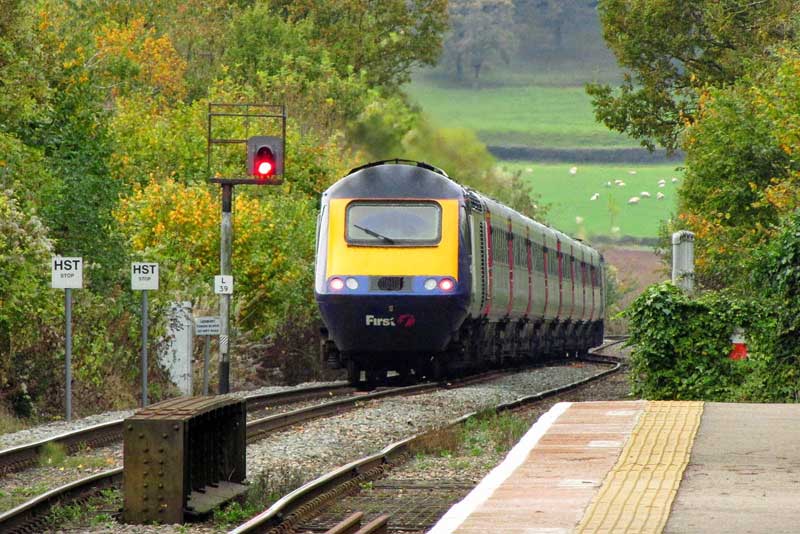
Shelwick Junction, just north of Hereford
The next station is Honeybourne. From 1905 until 1977 this was the
junction with the GWR line between Cheltenham and Stratford-upon-Avon.
The track to the north remains as a link to the large former military
depot at Long Marston. There is a good business case for the
restoration of the Stratford-Cotswolds link. The large compound to
the north with high walls, chapel, and floodlights is Long Lartin
prison. There is another level crossing, where Littleton and Badsey
station used to be. The line crosses the River Avon into Evesham.
Opposite Evesham's Cotswold Line station is the former Midland Railway
station, once on the Ashchurch & Barnt Green line. The line becomes
single track again about 1.6 km west of Evesham and then crosses the
River Avon again and follows it towards Pershore.
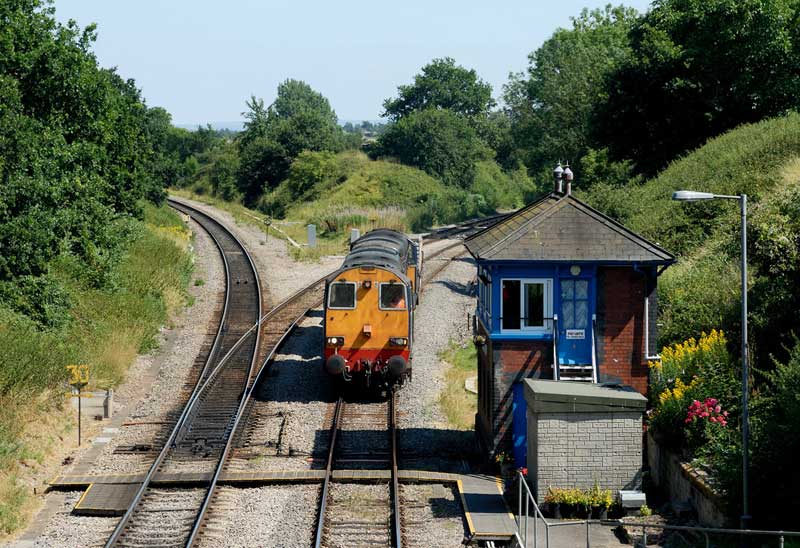
Norton Junction
The line crosses over the Cross Country Route and then passes
through Norton Junction where there was formerly a station. The
junction links the line to the Cross Country Route. Here double track
starts. Where the two routes cross is where the proposed Worcester
(Norton) Parkway station would be built.
About 92 km after Oxford is Worcester Shrub Hill station. Here are connections to commuter lines going to Birmingham New Street. If Worcester (Norton) Parkway is built Shrub Hill station will be closed. Worcester Foregate Street station gives connections to the city centre and other lines to Birmingham. 10 km later the line reaches Malvern Link station. Great Malvern station follows, and 2 miles (3 km) later is the site of the former Malvern Wells station.
After Malvern Wells the line enters the 1,448 m long Colwall New Tunnel. This is the second Colwall tunnel; the entrance to the original tunnel can be seen to the north. When the tunnel is below the ridge of the Malvern Hills, the line crosses the boundary between Worcestershire and Herefordshire. The line reaches Colwall station, where The Coca-Cola Company plant (now demolished) next to the station used to bottle Malvern Water, a local mineral water. Next to the bridge carrying the B4218 road over the railway is an unusual five-sided cottage. When the railway was built one corner had to be demolished and replaced by a plain wall. After passing through another tunnel, Ledbury station is passed and Hereford station ends the journey on the line.
History of the Line
The line between Oxford and Worcester was built and opened in 1851
as part of the Oxford, Worcester and Wolverhampton Railway. The Act
required the line to be built to Isambard Kingdom Brunel's 7 feet
1⁄4 inch (2,140 mm) broad gauge but delays, disputes and
increasing costs led to its being completed as 1,435 mm (4 ft 8
1⁄2 in) standard gauge. The first stage of the Worcester and
Hereford Railway opened between Henwick and Malvern Link on 25 July
1859. The bridge over the River Severn was approved for traffic the
following year, and trains started running through from Malvern Link to
Worcester Shrub Hill station on 17 May 1860. A short extension from
Malvern Link to Malvern Wells opened on 25 May 1860.
On 1 July 1860 the Oxford, Worcester and Wolverhampton Railway absorbed
both the Worcester & Hereford Railway and the Newport, Abergavenny
& Hereford Railway to form the West Midland Railway. On 13
September 1861 the final stage of the railway opened between Malvern
Wells and Shelwick Junction. The Great Western Railway took over the
West Midland Railway in 1863.
The original tunnel through the ridge of the Malvern Hills, Colwall
Tunnel, was completed in July 1860. However, the tunnel was unstable,
and it was closed for short periods in 1861 and again in 1907 following
rock falls. Eventually the GWR decided to build a new tunnel to the
south of the existing one. This opened for traffic on 2 August 1926.
The old tunnel was abandoned, and during the Second World War it was
used to store torpedoes.
Design by W3layouts


